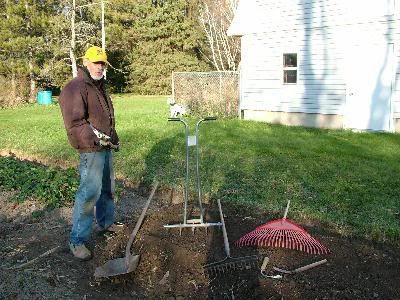I grew corn and cucumbers in this bed. It is the worst bed in the south garden in terms soil workability. It is dense yellow clay. It becomes brick hard as it dries. While years of adding compost and rotating crops though the bed have made it softer than it once was, it’s still far from friable. The nasty soil doesn’t seem to have any negative effect on the vegetables I grow. This year the corn and cukes were superb and when I do break up the clay, it’s loaded with earthworms, which has to be a good sign of fertility.
The second picture shows the tools I use to get the beds in shape. These are, from right to left, a Japanese grass sickle called a Kama, a CobraHead Weeder, a poly rake, a steel tined rake, a Glaser Biofork, a scoop shovel, and a CobraHead Long Handle, being held by me.
I use the grass sickle to edge the beds where they meet the lawn and to chop off roots from the lawn that encroach the garden paths. This little tool is dangerously sharp. It’s ideal for edging and doing some small scale mowing. I define my borders with this tool and with the long handled CobraHead.
The Glaser Biofork comes from Switzerland. It’s not too well known in the US, but it’s a great tool. I use it to do the initial break up of the bed. This tool is a lot lighter weight and easier to use than U-bars and other clunky devices that, in my opinion, are overkill for areas that are already under cultivation. A good garden spading fork would also work okay for this task, but the Biofork covers more ground in less time.
I use the small CobraHead weeder to pull out roots once I’ve broken the soil with a fork. I also use it to pull up the heavy clods along the edge of the beds and scalp and define the paths.
The poly rake sweeps up all the weeds and plant debris I pull out. In my system I don’t worry too much about weeds and weed seeds. I try not to let things go to seed, but most years I’m just not on top of things, so I’ve learned to live with weeds. I think they do well for the garden by bringing up good things from deep in the soil. I compost them all and I don’t worry whether I’ve cooked all the seeds out.
The scoop shovel works better than other spades and shovels for cleaning the paths and throwing loose soil back into the beds.
The CobraHead Long Handle does most of the work in the operation. I use it for clod busting, for cultivating and for tilling. Dragging it through the soil brings weeds and their roots to the surface, so I can get the beds pretty clean.
I usually work in two five gallon buckets of compost just as I’m finishing things up.
The steel tined rake is used to define the bed. My beds are approximately 5 1/2 feet wide, but that includes the sloped sides. I rake the top growing area to a slightly dished bed that is 3 feet wide. I have 18 beds in the south garden. They are laid out in a rectangular grid and each bed is about 20 feet long. The paths define the garden. I can usually keep the paths clean by scalping with the CobraHead Long Handle and using the leaves I’ve bought in to cover the beds as a mulch.
Once I get the bed to the stage shown here, I cover it with leaves. In the spring I just peel the leaves back, scratch up the soil and plant. The leaves are excellent for weed suppression, and they eventually break down to add more organic matter to the clay.


